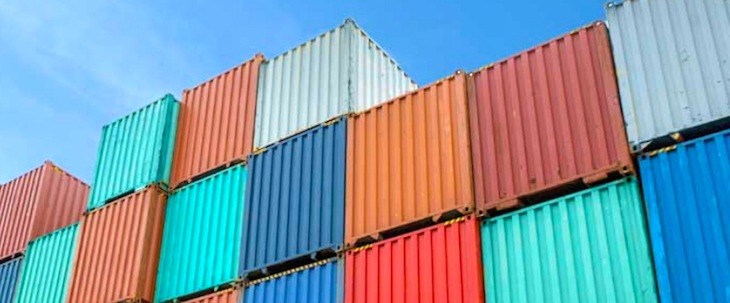Peak season has yet to meet expectations; intermodal volumes down 3%
by November 24, 2019 4:38 pm 566 views

The 2019 peak season has yet to meet expectations with drayage providers and more broadly across the transportation sector as intermodal volumes declined 3% in the third quarter.
Transportation technology company Next Trucking and Optimum Supply Chain recently released Preparing for Peak: The State of Drayage in 2019. The logistics industry had expected an early peak season with shippers importing goods ahead of possible tariffs and a regulation that looks to reduce ocean ship emissions. But this didn’t happen, the report shows.
“Last year’s peak was among the most beneficial seasons in history, with truck and rail each seeing increased volumes and revenues,” according to the report. “Through the lens of 2018, this year has been a disappointment. Geopolitical uncertainty has coupled with environmental and labor regulations to create a perfect storm; shippers literally don’t know what will happen next or when it will happen.
“We are confident that peak is coming, and that drayage will be critical to ensuring the flow of goods.”
With regard to Lowell-based carrier J.B. Hunt Transport Services Inc., drayage refers to the transportation of goods by truck to and from an intermodal facility. The carrier’s intermodal segment is its largest. In the third quarter, the segment account for 63% of its overall income and 52% of its overall revenue. J.B. Hunt executives have previously said they’ve not heard from customers who have pulled forward freight ahead of tariffs.
According to the Next Trucking report, effective drayage requires companies who often compete for business to be able to set aside their differences for the benefit of the overall supply chain. For example, ports could establish working groups to share best practices, even though they are competing for import and export volume. The collaboration can become challenging as each company tries to be different from others. And, some carriers have started to use systems that can easily connect with others. They might help to develop a modern supply chain and be the basis for digital transformation but will require standards before their full potential is realized, the report shows.
One could learn from the development of electronic information sharing and the 2,600 systems that are being used in logistics, according to the report. Many have required engineers and developers to write custom code to integrate. Without systems standards, logistics companies will face similar issues.
“Perhaps the most surprising finding in our research was a nearly universal paradox; the industry believes that small trucking companies are the most effective in drayage, while at the very same time, believes there must be heavy investment in technology such as GPS,” the report shows. “Something is bound to give.”
Fleets and transportation technology companies have started to use GPS in their apps to increase transparency; however, some of the companies don’t require drivers to keep their phones turned on. Other industry participants, such as chassis companies, have started to include GPS in their offerings. This allows the companies to track their assets and to determine their condition. J.B. Hunt completed the installation of tracking technology on all of the company’s more than 100,000 trailers and containers in 2018.
The number of drivers that can operate in ports is limited, according to the report. In the San Pedro Port, which is the largest port in the United States, 18,000 drivers can operate there. The limitation of the number of certified drivers at any given port has led to a capacity shortage. Shippers need contingency plans and to build relationships with carriers and owner-operators. For smaller fleets, which comprise about 90% of the trucking industry, making commitments to work that is hypothetical is difficult, the report shows. A solution could be to allow drivers who are certified to drive in ports to haul a full container from a port to a nearby location and return to the port with an empty container.
A lack of consistency in billing was another issue, the report shows. Also, 81% of shippers said terminals were chokepoints that create issues. Some terminals are working to improve visibility and transparency. They are using webcams to monitor truck processing time and queuing time outside the gates. Some programs also allow truck drivers more time to pick up containers. A solution to create more terminal capacity might be to route ships to terminals with more availability, the report shows.
Intermodal container shipping spot rates were 7 cents per mile higher in October, from September, while national over-the-road, dry-van truckload rates fell 3 cents per mile, according to a recent article in FreightWaves. Some of the rise could be attributed to the increase in fuel prices after the Saudi oil attacks in mid-September. The average price per gallon of diesel has increased by about 8 cents per gallon since the attacks. This accounts for about 2 cents to 3 cents per mile of the spot rate increase.
Total intermodal volumes fell 3.7% in the third quarter of 2019, from the same period in 2018, according to the Intermodal Association of North America (IANA). International shipments fell 0.8% from 2018, while domestic containers and trailers declined 4.9% and 17.6%, respectively.
“Looser trucking capacity, continuing uncertainty about Chinese tariffs, and tough comparisons to 2018 volumes are the primary factors driving intermodal traffic,” said Joni Casey, president and CEO of IANA. “The rest of the year is projected to be flat, but a turnaround is anticipated by the (second quarter) of next year.”
Total intermodal container volume fell 7.6% in the third quarter. Both intermodal and highway loads decreased for only the third time since the Great Recession.
